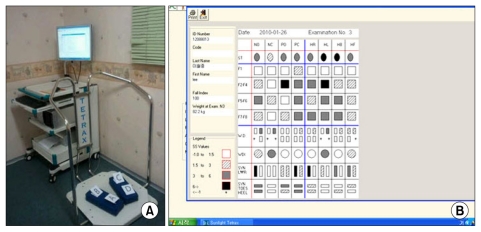1. Hassan BS, Mockett S, Doherty M. Static postural sway, proprioception, and maximal voluntary quadriceps contraction in patients with knee osteoarthritis and normal control subjects. Ann Rheum Dis 2001;60:612-618. PMID:
11350851.



2. Brandt KD, Dieppe P, Radin EL. Etiopathogenesis of osteoarthritis. Rheum Dis Clin North Am 2008;34:531-539. PMID:
18687271.


3. Martel-Pelletier J. Pathophysiology of osteoarthritis. Osteoarthritis Cartilage 1998;6:374-376. PMID:
10343769.


4. Barrett DS, Cobb AG, Bentley G. Joint proprioception in normal, osteoarthritic and replaced knees. J Bone Joint Surg Br 1991;73:53-56. PMID:
1991775.


5. Marks R, Quinney HA, Wessel J. Proprioceptive sensibility in women with normal and osteoarthritic knee joints. Clin Rheumatol 1993;12:170-175. PMID:
8358974.


6. Pandya NK, Draganich LF, Mauer A, Piotrowski GA, Pottenger L. Osteoarthritis of the knees increases the propensity to trip on an obstacle. Clin Orthop Relat Res 2005;431:150-156. PMID:
15685069.

7. Lee KM, Kang JW, Han SH. Evaluation of standing balance in hemiplegic patients using the functional reach test. J Korean Acad Rehabil Med 2002;26:647-651.
8. Lee JJ, Lee HJ, Park JH, Han EY, Kim MJ, Jung HY. The Korean version of berg balance scale as an index of activity related to ambulation in subjects with stroke. J Korean Acad Rehabil Med 2007;31:400-403.
9. Jung HY, Park JH, Shim JJ, Kim MJ, Hwang MR, Kim SH. Reliability test of Korean version of berg balance scale. J Korean Acad Rehabil Med 2006;30:611-618.
10. Hermodsson Y, Ekdahl C, Persson BM, Roxendal G. Standing balance in trans-tibial amputees following vascular disease or trauma: a comparative study with healthy subjects. Prosthet Orthot Int 1994;18:150-158. PMID:
7724348.


11. Oppenheim U, Kohen-Raz R, Alex D, Kohen-Raz A, Azarya M. Postural characteristics of diabetic neuropathy. Diabetes Care 1999;22:328-332. PMID:
10333953.


12. Dehner C, Heym B, Maier D, Sander S, Arand M, Elbel M, Hartwig E, Kramer M. Postural control deficit in acute QTF grade whiplash injuries. Gait Posture 2008;28:113-119. PMID:
18083031.


13. Kim BR, Choi KH, Chun MH, Lee MC, Chung SJ, Jang KW. Evaluation of balance control in patients with idiopathic Parkinson's disease using tetra-ataxiometric posturography. J Korean Acad Rehabil Med 2009;33:538-546.
14. Masui T, Hasegawa Y, Yamaguchi J, Kanoh T, Ishiguro N, Suzuki S. Increasing postural sway in rural-community-dwelling elderly persons with knee osteoarthritis. J Orthop Sci 2006;11:353-358. PMID:
16897198.


15. Thorp LE, Sumner DR, Block JA, Moisio KC, Shott S, Wimmer MA. Knee joint loading differs in individuals with mild compared with moderate medial knee osteoarthritis. Arthritis Rheum 2006;54:3842-3849. PMID:
17133592.


16. Altman R, Asch E, Bloch D, Bole G, Borenstein D, Brandt K, Christy W, Cooke TD, Greenwald R, Hochberg M, et al. Diagnostic and Therapeutic Criteria Committee of the American Rheumatism Association. Development of criteria for the classification and reporting of osteoarthritis. Classification of osteoarhritis of the knee. Arthritis Rheum 1986;29:1039-1049. PMID:
3741515.


17. Shumway-Cook A, Brauser S, Woollacott M. Predicting the probability for falls in community-dwelling older adults using the Timed Up & Go Test. Phys Ther 2000;80:896-903. PMID:
10960937.


18. Berg K, Wood-Dauphinee S, Williams JI. The Balance Scale: reliability assessment with elderly residents and patients with an acute stroke. Scand J Rehabil Med 1995;27:27-36. PMID:
7792547.

19. Avni N, Avni I, Barenboim E, Azaria B, Zadok D, Kohen-raz R, Morad Y. Brief posturographic test as an indicator of fatigue. Psychiatry Clin Neurosci 2006;60:340-346. PMID:
16732751.


20. Kohen-Raz R. Application of tetra-ataxiametric posturography in clinical and developmental diag nosis. Percept Mot Skills 1991;73:635-656. PMID:
1766798.


21. Yoshida S, Aoyagi K, Felson DT, Aliabadi P, Shindo H, Takemoto T. Comparison of the prevalence of radiographic osteoarthritis of the knee and hand between Japan and the United States. J Rheumatol 2002;29:1454-1458. PMID:
12136905.

22. Gardner MM, Robertson MC, Campbell AJ. Exercise in preventing falls and fall related injuries in older people: a review of randomized controlled trials. Br J Sports Med 2000;34:7-17. PMID:
10690444.



23. Barnett A, Smith B, Lord SR, Williams M, Baumand A. Community-based group exercise improves balance and reduces falls in at-risk older people: a randomized controlled trial. Age Ageing 2003;32:407-414. PMID:
12851185.















